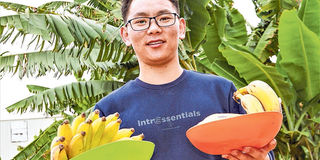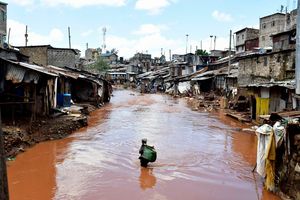Our bountiful banana harvest from flower beds

Wang Huan Yang, the China Construction Communication Company Ltd official in-charge of camp in Emali displays harvests from crops including bananas that they cultivate at the campsite. The bananas that they grow have enabled the campsite to significantly cut down on the cost of food supplies. PHOTO | PIUS MAUNDU | NMG
What you need to know:
- Dickson Ekesa, the gardener in-charge of the project, says they sourced all the landscaping fruit trees from local suppliers, with Allois Mwaiwa, a farmer in Emali, supplying all the suckers.
- The bananas have enabled the campsite to significantly cut down on the cost of food supplies.
- Sultan Hamud Primary School, a public school near the Chinese campsite, is among institutions that have borrowed the landscaping idea.
- Before using food crops for landscaping a homestead or an office block, one should consider the root and vegetative behaviour of the plants.
Many travellers riding the standard gauge railway train often crane their necks when they reach Section 7, a campsite run by the Chinese near Emali in Kajiado County.
The sprawling site, which hosts staff quarters and a concrete beam manufacturing workshop for the railway line, stands out from its sun-baked surrounding, thanks to its flourishing gardens.
The gardens, which sit around the office block, the staff quarters and the workshop and were established in 2014, are always teeming with banana and avocado plants. The crops sit on space that would ordinarily be taken up by flowers.
Seeds of Gold finds two workers harvesting bunches of bananas near the staff quarters, whose walls carry insignia in Mandarin extolling the virtues of environmental conservation.
“When the railway project started, this place was bare and hot. There was an urgent need of making the compound beautiful. We included bananas and avocados in the landscaping design of the campsite to make it habitable. The avocados have not responded very well but the bananas have thrived into a big garden with more than 2,000 plants," Wang Huan Yang, the China Construction Communication Company Ltd official in-charge of the camp says.
Dickson Ekesa, the gardener in-charge of the project, says they sourced all the landscaping fruit trees from local suppliers, with Allois Mwaiwa, a farmer in Emali, supplying all the suckers.
“We planted the suckers in bunches of three in holes measuring at least a metre in width and depth. We then filled the holes halfway with top soil mixed with organic manure before planting the suckers,” says Ekesa, adding the bananas are watered daily.
During our visit, more than 100 bananas were ready for harvesting.
“We harvest them before they ripen," says Ekesa, a trained landscaping artist behind the work.
Workers harvest the fruits daily for consumption at the campsite.
CUT DOWN ON COSTS
“We have more bananas than the workers require. If we had planted flowers, all we would be having now is beauty but we now have also food,” he says.
The bananas have enabled the campsite to significantly cut down on the cost of food supplies.
The Chinese company also uses the bananas to boost its relationship with the local community.

Huan Yang and an employee at the campsite display bananas that they grow. The crops sit on space that would ordinarily be taken up by flowers. PHOTO | PIUS MAUNDU | NMG
“We have turned out to be a breeding ground for bananas. We invite farmers and local institutions to collect suckers for free to establish their farms,” said Wang.
Sultan Hamud Primary School, a public school near the Chinese campsite, is among institutions that have borrowed the landscaping idea.
The school got suckers from the camp and has used them for landscaping. In addition to providing aesthetics, landscaping helps to prevent soil erosion and serve as a source of food like in the case of kitchen gardens and orchards, according to Judy Wambua, who teaches landscaping at South East Kenya University.
“The choice of landscaping materials should be informed by the intended purpose. More people are now combining multiple use plants in their landscapes. Using edible plants as part of a landscape is more beneficial since the landscape provides food at the same time beautifies the compound. However, edible plants should not be planted in areas where they are likely to be contaminated. Some of the places to avoid include along motorways where emissions from vehicles will be directed on the crops," says Wambua.
Before using food crops for landscaping a homestead or an office block, one should consider the root and vegetative behaviour of the plants.
“Some trees come with a root system that can damage the walls of buildings,” says Wambua.
She adds that one should figure out how to cope with pests and diseases associated with the landscaping plants.





